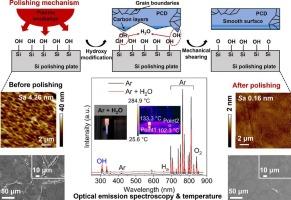Microwave plasma-assisted polishing of polycrystalline diamond
IF 5.1
3区 材料科学
Q2 MATERIALS SCIENCE, COATINGS & FILMS
引用次数: 0
Abstract
Polycrystalline diamond (PCD) is widely used in electronic, optical, and thermal devices because of its excellent physical and chemical properties. However, achieving a smooth surface on PCD remains a significant challenge due to its extreme hardness, toughness, and strong chemical inertness. In this study, microwave plasma-assisted polishing (MW-PAP) using a silicon polishing plate is utilized to polish the PCD. The surfaces of both the silicon plate and PCD substrate are modified by hydroxyl radicals (⁎OH) produced by argon-based microwave plasma containing water vapour, initating a dehydration condensation reaction. Surface atoms on the PCD are then removed through mechanical shearing under a polishing load of 3 N. With the application of MW-PAP, a smooth PCD surface with the Sa roughness of 10.7 nm (over 300 × 300 μm2) and 0.16 nm (over 10 × 10 μm2) is obtained with a material removal rate of 441 nm/h. MW-PAP effectively prevents impurity contamination and graphitization by removing carbon atomic layers during the polishing process, resulting in a low damage PCD surface. In conclusion, MW-PAP demonstrates the ability to effectively achieve an atomic-scale smooth and low damage surface of PCD, making it a promising approach for the finishing of PCD substrates.

多晶金刚石的微波等离子体辅助抛光
聚晶金刚石(PCD)因其优异的物理和化学性能而广泛应用于电子、光学和热工器件中。然而,由于其极高的硬度、韧性和强化学惰性,在PCD上实现光滑表面仍然是一个重大挑战。在这项研究中,微波等离子体辅助抛光(MW-PAP)利用硅抛光板抛光PCD。含水蒸气的氩基微波等离子体产生的羟基自由基(OH)修饰了硅板和PCD衬底的表面,引发了脱水缩合反应。在3 n的抛光载荷下,通过机械剪切去除PCD表面的原子。应用MW-PAP,获得了Sa粗糙度为10.7 nm (300 × 300 μm2以上)和0.16 nm (10 × 10 μm2以上)的PCD表面,材料去除率为441 nm/h。MW-PAP在抛光过程中去除碳原子层,有效防止杂质污染和石墨化,使PCD表面损伤低。综上所述,MW-PAP能够有效地实现PCD的原子尺度光滑和低损伤表面,使其成为PCD衬底精加工的一种很有前途的方法。
本文章由计算机程序翻译,如有差异,请以英文原文为准。
求助全文
约1分钟内获得全文
求助全文
来源期刊

Diamond and Related Materials
工程技术-材料科学:综合
CiteScore
6.00
自引率
14.60%
发文量
702
审稿时长
2.1 months
期刊介绍:
DRM is a leading international journal that publishes new fundamental and applied research on all forms of diamond, the integration of diamond with other advanced materials and development of technologies exploiting diamond. The synthesis, characterization and processing of single crystal diamond, polycrystalline films, nanodiamond powders and heterostructures with other advanced materials are encouraged topics for technical and review articles. In addition to diamond, the journal publishes manuscripts on the synthesis, characterization and application of other related materials including diamond-like carbons, carbon nanotubes, graphene, and boron and carbon nitrides. Articles are sought on the chemical functionalization of diamond and related materials as well as their use in electrochemistry, energy storage and conversion, chemical and biological sensing, imaging, thermal management, photonic and quantum applications, electron emission and electronic devices.
The International Conference on Diamond and Carbon Materials has evolved into the largest and most well attended forum in the field of diamond, providing a forum to showcase the latest results in the science and technology of diamond and other carbon materials such as carbon nanotubes, graphene, and diamond-like carbon. Run annually in association with Diamond and Related Materials the conference provides junior and established researchers the opportunity to exchange the latest results ranging from fundamental physical and chemical concepts to applied research focusing on the next generation carbon-based devices.
 求助内容:
求助内容: 应助结果提醒方式:
应助结果提醒方式:


